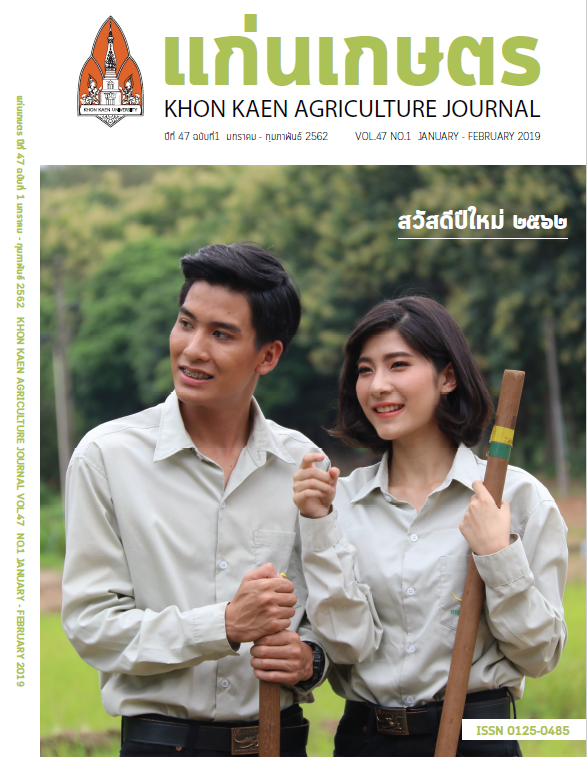การเปรียบเทียบวิธีการแช่แข็งและการทำละลายต่อคุณภาพน้ำเชื้อสุกรแช่แข็ง
Main Article Content
บทคัดย่อ
วัตถุประสงค์ของงานวิจัยครั้งนี้เพื่อเปรียบเทียบวิธีการการแช่แข็งและการทำละลายน้ำเชื้อสุกรแช่แข็งต่อคุณภาพน้ำเชื้อภายหลังการทำละลาย รีดน้ำเชื้อจากสุกร พันธุ์เปียแตรง จำนวน 1 ตัว และพันธุ์ดูร็อกจำนวน 1 ตัว ตัวละ 2 ซ้ำ ทำการลดอุณหภูมิในกระบวนการแช่แข็งแบบอังไอไนโตรเจนเหลวที่แตกต่างกัน 2 วิธี ได้แก่ ทรีทเมนต์ที่ 1: -35 OC เป็นเวลา 5 นาที และ -120 OC เป็นเวลา 10 นาที (สูงจากระดับ ไนโตเจนเหลว11 และ 5 เซนติเมตร) และทรีทเมนต์ที่ 2: -135 OC เป็นเวลา 20 นาที (สูงจากระดับ ไนโตเจนเหลว 3 เซนติเมตร) ร่วมกับวิธีการทำละลายน้ำเชื้อ 3 วิธี (60 OC เป็นเวลา 8 วินาที; 42 OC เป็นเวลา 25 วินาที; และ 5 OC เป็นเวลา 5 นาที) ประเมินคุณภาพน้ำเชื้อด้านการเคลื่อนที่ไปข้างหน้าของอสุจิ การมีชีวิตรอดของอสุจิ และความ สมบูรณ์ของเยื่อหุ้มเซลล์ หลังการเก็บที่อุณหภูมิ -196 OC และทำการละลายตามวิธีข้างต้น ผลการศึกษาพบว่า สายพันธุ์เปียแตรง มีการเคลื่อนที่ไปข้างหน้าของอสุจิสูงกว่าดูร็อก (P<0.05) วิธีการแช่แข็ง ทรีทเมนต์ที่ 1มีผลทำให้คุณภาพน้ำเชื้อด้านการเคลื่อนที่ไปข้างหน้าของอสุจิ และการมีชีวิตรอดของอสุจิ สูงกว่าทรีทเมนต์ ที่ 2 (P<0.05) ส่วน วิธีการทำละลายน้ำเชื้อพบว่า การทำละลายน้ำเชื้อแช่แข็งที่ระดับอุณหภูมิ 5 OC เป็นเวลา 5 นาที และ 60 OC เป็นเวลา 8 วินาที มีผลทำให้คุณภาพน้ำเชื้อสูงขึ้นในทุกพารามิเตอร์ที่ทำการศึกษาเมื่อเปรียบเทียบกับที่ระดับ 42 OC เป็นเวลา 25 วินาที (P<0.05) อย่างไรก็ตามพบว่าอิทธิพลร่วมระหว่างวิธีการแช่แข็งและการทำละลายให้ผลไม่แตกต่างกันอย่างมีนัยสำคัญทางสถิติ จึงสรุปได้ว่า วิธีการแช่แข็งในทรีท เมนต์ที่ 1 ร่วมกับวิธีการทำละลายน้ำเชื้อที่ระดับ 5 OC เป็นเวลา 5 นาที ส่งผลให้คุณภาพน้ำเชื้อสุกรภายหลังการแช่แข็งภายหลังการทำละลายดีที่สุด
Article Details
เอกสารอ้างอิง
เทวินทร์ วงษ์พระลับ. 2542. การสืบพันธุ์ในสัตว์ เลี้ยง Reproductive in domestic animals. โรงพิมพ์มหาวิทยาลัยขอนแก่น, ขอนแก่น.
Amidi. F., A. Pazhohan, M.S. Nashtaei, M. Khodarahmian, and S. Nekoonam. 2016. The role of antioxidants in sperm freezing: a review. Cell. Tissue Bank. 17:745-756.
Athurupana, R., S. Ioki and H. Funahashi. 2015. Rapid thawing and stabilizing procedure improve postthaw survival and in vitro penetrability of boar spermatozoa cryopreserved with a glycerol-free trehalose-based extender. Theriogenology. 84:940-947.
Bamba, K., and D.G. Cran. 1988. Further studies on rapid dilution and warming of boar semen. J. Reprod. Fertil. 82:509-518.
Chanapiwat, P., K. Kaeoket and P. Tummaruk. 2012. Cryopreservation of boar semen by egg yolk-based extenders containing lactose or fructose is better than sorbitol. J. Vet. Med. Sci. 74(3): 351–354.
Chanapiwat, P., E.O. Olanratmanee., K. Kaeoket and P. Tummaruk. 2014. Conception rate and litter size in multiparous sows after intrauterine insemination using frozen-thawed boar semen in a commercial swine herd in thailand. J. Vet. Med. Sci. 76: 1347–1351.
Chanapiwat, P. and K. Kaeoket. 2015. Breed of boar influences the optimal concentration of gamma-oryzanol needed for semen cryopreservation. Reprod. Domest. Anim. 50: 221–226.
Chuaychu-Noo. N., P. Thananurak, V. Chankitisakul, and T. Vongpralub. 2017. Supplementing rooster sperm with cholesterol-loadedcyclodextrinimproves fertility after cryopreservation. Cryobiology. 74:8-12.
Dai, J. J., C. F. Wu, D. F. Zhang, F. Z. Yin, T. Y. Zhang, D. Liu, H. L. Wu, L. L. Li, S. T. Yang and L. Wang. 2009. Some Factors Affecting Freezing of Boar Semen in 5 ml Maxi-straws. Asian-Aust. J. Anim. Sci. 22:507 – 515.
Fazano, F.A.T., 1986. ZurKryokonservierung von Ebersperma verschiedene Verfahren zur Samenbehandlung und u n t e r s c h i e d l i e d l i c h e Konfektionierungsmetoden unter besonderer Berücksichtigung der Einfriergeschwindigkeit. Thesis, Hannover Veterinary College.
Fraser, L., L. Zasiadczyk, and J. Strzezek, 2010. Interactions of egg yolk lipoprotein fraction with boar spermatozoa assessed with a fluorescent membrane probe. Folia. Histochem. Cytobiol. 48:292-298.
Gilmore, J.A., D. Junying, T. Jun, A.T. Peter, and J.K. Crister. 1996. Osmotic properties of boar spermatozoa and their relevance to cryopreservation. J. Reprod. Fertil. 107:87-95.
Gao, D., and JK. Critser. 2000. Mechanisms of cryoinjury in living cells. ILAR. J. 41:96-187.
Kaeoket, K., K.Tantiparinyakul, W. Kladkaew, P. Chanapiwat, and M. Techakumphu 2008. Effect of different antioxidants on quality of cryopreserved boar semen in different breeds. Thai J. Agri. Sci. 41:1-9.
Marko S., T. Dobranic, S. Kruslin, M. Cergolj, M. Karadjole, N. Prvanovic, and J. Grizelj. 2008. The use of the hypoosmotic swelling test and supravital staining in evaluation of sperm quality in boars. Vet. Arh. 78:279-287.
Mazur, P., and K.W.Cole. 1985. Influence of cell concentration on the contribution of unfrozen fraction and salt concentration to the survival of slowly frozen human erythrocytes. Cryobiology. 22:509-536.
Muldrew, K., and LE. McGann. 1994. The osmotic rupture hypothesis of intracellular freezing injury. Biophys. J. 66:532-541.
Okazaki, T., and M. Shimada. 2012. New trategies of boar sperm crypreservation development of novel freezing and thawing methods with a focus on the roles of seminal plasma. Anim. Sci. J. 83:623-629.
Parks, J.E. and D.V. 1992. Lynch. Lipid composition and thermotropic phase behavior of boar, bull, stallion, and rooster sperm membranes. Cryobiology. 29: 255-266.
Rodriguez-Gil, J.E., and E. Estrada. 2013. Artificial insemination in boar reproduction. In:zBonet S, Casas I, Holt WV, Yeste M(eds), Boar Reproduction. Springer, Berlin.
Rodriguez-Martinez, H., and M. Wallgren. 2011. Advances in boar semen cryopreservation. Vet. Med. Inter. 2011:1-5.
Schulze, M., D. Waberski, S. Buder, K. Rudiger, and M. Beyerbach. 2014. Influences on semen traits used for selection of young AI boars. Anim. Reprod. Sci. 148:164-170.
Steel, R.G.D., and J.H. Torrie. 1980. Principle and procedures of statistics: A Biomaterial Approach. 2nd Ed. McGraw Hill Book Co., New York.
Tierz, A., A. M. Kawecka, A. Pietruszka, E. Jacyno, R. Czarnecki, and M. Kamyczek. 2008. Quality of semen of young boars of the breeds Pietrain and Duroc and their reciprocal crosses. Dummerstorf. 51:42-54.
Tomas, C., J. Gomez-Fernandez, E. GomezIzquierdo, and E. de Mercado. 2014. Effect of the holding time at 15°C prior to cryopreservation, the thawing rate and the post-thaw incubation temperature on the boar sperm quality after cryopreservation. Anim. Reprod. Sci. 144:115-121.
Vongpralub, T. 2016. Semen storage and artificial insemination in poultry. Khon Kaen University, Khon Kaen.
Vongpralub, T., A. Utha, J. Pongpeng, P. Sonseeda, and W. Yindee 2011. A comparison of simple vapour method and programmable freezer on motility and fertility of frozen Thai native frozen semen. Proceeding of The 3th international conference on sustainable animal agriculture for developing countries, July 26-29, 2011, Nakhon Ratchasima, Thailand.
Waterhouse, K.E., P.O. Hofmo, A. Tverdal, and R.R. Miller Jr. 2006. Within and between breed differences in freezing tolerance and plasma membrane fatty acid composition of boar sperm. Reproduction. 131:887-894.
Wiest, S.C., and P.L. Steponkus. 1979. The osmometric behavior of human erythrocytes. Cryobiology. 16:101-104.
Yeste, M. 2015. Recent advances in boar sperm cryopreservation: state of the art and current perspectives. Reprod. Domest. Anim. 50:71-79.
Yeste, M. 2016. Sperm cryopreservation update: cryodamage, markers, and factors affecting the sperm freezability in pigs. Theriogenology. 85:47-56.


